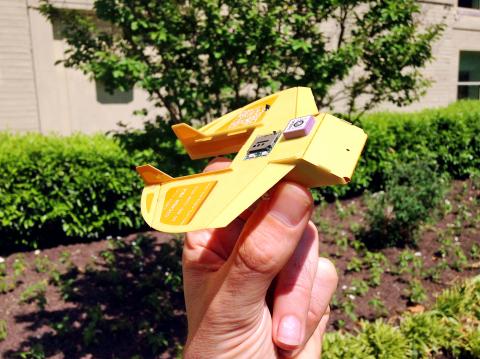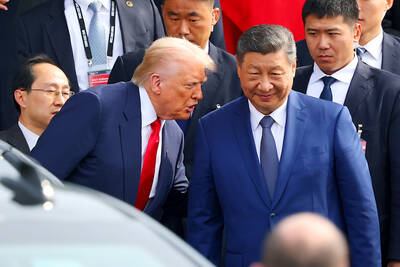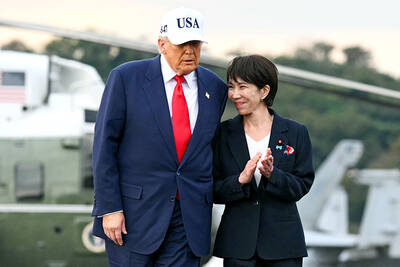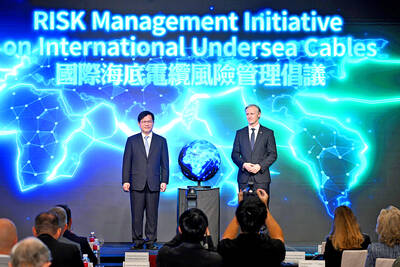US military scientists have invented a miniature drone that fits in the palm of a hand, ready to be dropped from the sky like a mobile phone with wings.
The “micro air vehicle” is named after the insect that inspired its invention, the cicada, which spends years underground before appearing in great swarms, reproducing and then dropping to the ground dead.
“The idea was: Why can’t we make UAVs [uncrewed aerial vehicles] that have the same sort of profile,” US Naval Research Laboratory flight controls engineer Aaron Kahn told reporters. “We will put so many out there, it will be impossible for the enemy to pick them all up.”

Photo: AFP
The “Cicada” — short for covert autonomous disposable aircraft — was designed to be smaller, cheaper and simpler than any other robotic aircraft, but still able to carry out a mission in a remote battlefield.
The prototype cost just US$1,000 and the cost could come down to as little as US$250 per unit, Kahn said.
With no motor and about 10 parts, the Cicada resembles a paper airplane with a circuit board.
It is designed to glide to programmed GPS coordinates after being dropped from an aircraft, a balloon or a larger drone, researchers said.
In a test about three years ago in Yuma, Arizona, Cicada drones were released from 17,500m. The drones flew — or fell — 18km, landing within 5m of their target.
The Cicada can fly at 74kph per hour and are virtually silent, with no engine or propulsion system.
“It looks like a bird flying down,” Naval Research Laboratory aerospace engineer Daniel Edwards said. “[However,] it’s very difficult to see.”
In the flight test, the Cicada had sensors that could send back readings for temperature, air pressure and humidity.
Researchers said the mini-drones could be used for a myriad of missions.
“They are robotic carrier pigeons. You tell them where to go and they will go there,” Edwards said.

UKRAINE, NVIDIA: The US leader said the subject of Russia’s war had come up ‘very strongly,’ while Jenson Huang was hoping that the conversation was good Chinese President Xi Jinping (習近平) and US President Donald Trump had differing takes following their meeting in Busan, South Korea, yesterday. Xi said that the two sides should complete follow-up work as soon as possible to deliver tangible results that would provide “peace of mind” to China, the US and the rest of the world, while Trump hailed the “great success” of the talks. The two discussed trade, including a deal to reduce tariffs slapped on China for its role in the fentanyl trade, as well as cooperation in ending the war in Ukraine, among other issues, but they did not mention

CALL FOR SUPPORT: President William Lai called on lawmakers across party lines to ensure the livelihood of Taiwanese and that national security is protected President William Lai (賴清德) yesterday called for bipartisan support for Taiwan’s investment in self-defense capabilities at the christening and launch of two coast guard vessels at CSBC Corp, Taiwan’s (台灣國際造船) shipyard in Kaohsiung. The Taipei (台北) is the fourth and final ship of the Chiayi-class offshore patrol vessels, and the Siraya (西拉雅) is the Coast Guard Administration’s (CGA) first-ever ocean patrol vessel, the government said. The Taipei is the fourth and final ship of the Chiayi-class offshore patrol vessels with a displacement of about 4,000 tonnes, Lai said. This ship class was ordered as a result of former president Tsai Ing-wen’s (蔡英文) 2018

Japanese Prime Minister Sanae Takaichi yesterday lavished US President Donald Trump with praise and vows of a “golden age” of ties on his visit to Tokyo, before inking a deal with Washington aimed at securing critical minerals. Takaichi — Japan’s first female prime minister — pulled out all the stops for Trump in her opening test on the international stage and even announced that she would nominate him for a Nobel Peace Prize, the White House said. Trump has become increasingly focused on the Nobel since his return to power in January and claims to have ended several conflicts around the world,

GLOBAL PROJECT: Underseas cables ‘are the nervous system of democratic connectivity,’ which is under stress, Member of the European Parliament Rihards Kols said The government yesterday launched an initiative to promote global cooperation on improved security of undersea cables, following reported disruptions of such cables near Taiwan and around the world. The Management Initiative on International Undersea Cables aims to “bring together stakeholders, align standards, promote best practices and turn shared concerns into beneficial cooperation,” Minister of Foreign Affairs Lin Chia-lung (林佳龍) said at a seminar in Taipei. The project would be known as “RISK,” an acronym for risk mitigation, information sharing, systemic reform and knowledge building, he said at the seminar, titled “Taiwan-Europe Subsea Cable Security Cooperation Forum.” Taiwan sits at a vital junction on